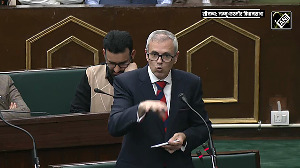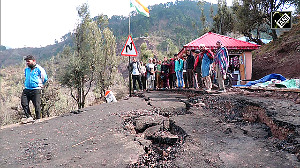With the transport sector responsible for a fourth of greenhouse gas emissions, the debate over the impact of cars such as the Tata one is going to get more strident. Here are two views on the issue.
R K Pachauri
Director-General, TERI & Chairman, IPCC
The proliferation of small cars with higher incomes will result in a nightmarish situation on both emission levels and congestion in and between cities.
The recently concluded Conference of the Parties to the UN Framework Convention on Climate Change came up with a final declaration that highlighted the need for "deep cuts" in emissions of greenhouse gases to combat the problem of global climate change. The tone and content of the Bali Conference represented a perceptible departure from previous such meetings, in view of the major impacts of climate change assessed in great detail in the Fourth Assessment Report of the Intergovernmental Panel on Climate Change (IPCC).
Essentially, the problem of climate change, which is the result of cumulative emissions of greenhouse gases (GHGs) since the beginning of industrialisation, represents only a part of the much larger problem of unsustainable development. While the world has achieved remarkable success through innovation in providing the means for satisfying the needs of the human race, there are also several distortions which have taken place and grown as a result.
In the case of transport, for instance, both in the developed world (most notably exemplified by the situation in North America) and in the developing world, there appears to be a race towards larger ownership of private vehicles and their use for transportation related to occupational as well as recreational activities.
Between 1950 and 1997, the automobile fleet of the world increased from 50 million vehicles to 580 million vehicles, five times faster than the growth in population. The transport sector is responsible for 23 per cent of world's energy-related GHG emissions, with 74 per cent of this share coming from road transport.
Of greater concern is the projection that carbon emissions would be about 80 per cent higher than current levels by 2030. This, therefore, represents one sector where major changes are expected to take place to reduce GHG emissions. It is likely, therefore, that the transport sector across the world will undergo radical transformation.
We in India have been largely neglecting the provision of public transport, as a result of which firstly, those who do not have the means cannot afford vehicular transportation, with severe restrictions in their mobility.
Secondly, the rate of growth of private vehicles also impinges seriously on traffic congestion and air quality. The proliferation of small cars with higher incomes will lead to a massive increase in their population, exaggerating these problems with nightmarish consequences both within and between cities. While the worldwide desire to own motor vehicles is something that is unlikely to change, the provision of public transport would have a major impact in reducing car usage.
Hence, the impending growth in private vehicles only adds to the imperative of providing massive expansion of public transport to wean away passengers from driving in the absence of choices. The welfare benefits of public transport far outweigh any measure of GDP growth or employment consequences of the runaway growth of car ownership and usage, a fact that governments would do well to understand and act on.
B V R Subbu
Former President, Hyundai Motors India
Denying people the right to upgrade from 2/3 wheelers is elitist. But we need to tighten emission norms and also check other large emitters seriously.
Years ago when I was asked for my reactions to the announcement of the 'one lakh car', I recall saying that it would be an impressive engineering effort if indeed that price point was ultimately met, while attaining global safety and emission standards, or words to that effect.
Given that car prices have indeed not really risen in the intervening period, definitely so in real terms, I expect that the one-lakh consumer price point claim/desire still stands. That would earn Tata Motors enormous stature and credibility in the global auto arena that it appears well-poised to stride on. And, of course, it would metamorphose the Indian car market.
Millions more would be able to afford their aspiration of a new, safe and inexpensive family transport medium -- a role that has been rather creditably, if not very safely, been performed for decades by two and three wheelers.
Why would anyone want to deny Indians their version of the Cinquecento, by talking of environmental doomsday scenarios? I can, of course, dismiss the reactions as horribly elitist. But look at who's saying it. And think. Is there a way out to meet people's aspirations for low-cost safe mobility and ensure that we are not staring at an ecological disaster in the making?
Indeed there is.The present ARAI system, of CoP testing of a carefully prepared sample, leaves a lot to be desired. Let's start by creating a non-industry body, maybe led by the CSE, that draws out new cars from showrooms and cars in use for one month, and tests them for compliance to certified emission norms.
Then impose heavy penalties on companies whose products fail the test. Monetary penalties, if the fail rate is below 25 per cent, and complete stoppage of production for one to three months, if the fail rate exceeds that limit.
The logic is simple. If cars are produced to specified standards, consistent quality and emission compliance can be ensured. When original equipment manufacturers (OEMs) expect zero parts per million (PPM) rejections from suppliers, they are already geared to ensuring consistent product quality and performance on all parameters including emission. None of them should have any complaints.
As a next step, start a strict periodic MoT-type certification for all cars of over 15 years' vintage and increase the consumers' costs of operating environmentally unfriendly vehicles. Simultaneously ask manufacturers to take on the responsibility of end-of-life disposal issues, as they would do in much smaller and much less profitable global markets. Maybe we also need to work towards a zero tax regime for low-emission vehicles (LEVs), rather than for cars produced in Uttarakhand.
If we are really serious about the environment, let's ask how we allow a thousand acres of rich agrcultural land to be converted into a car plant that would make 100,000 cars, when the Japanese make 700,000 cars on a 90-acre plot.
Let's ask how we allow energy-guzzling glass bulidings in Gurgaon. Let's ask why India is becoming a dump for the world's electronic waste. Let's ask what we are doing about the dyes industry, or asbestos industry, or our power plants. Let's ask questions of ourselves, and try to provide honest answers.







 © 2025
© 2025